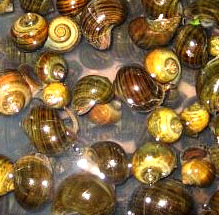 Golden apple snail (Pomacea Tcanalicuta), locally known as golden kuhol, was first introduced into Philippine farms in 1983. It is now cultured all over the country because it is easy to raise and is good for food. An average-sized golden kuhol contains protein, carbohydrates, phosphorus, sodium, potassium, riboflavin, and niacin.
Golden apple snail (Pomacea Tcanalicuta), locally known as golden kuhol, was first introduced into Philippine farms in 1983. It is now cultured all over the country because it is easy to raise and is good for food. An average-sized golden kuhol contains protein, carbohydrates, phosphorus, sodium, potassium, riboflavin, and niacin.
In addition to its nutritive value, the golden kuhol reproduces fast. It is easier to culture because it has tough eggs and larvae. It is also adaptable to crowding. As many as 5 kg of the snails can be stocked in a square metre of space without encountering culture problem. It can survive or even thrive in water with zero oxygen level, such as stagnant pool, because it has two breathing gills and a lung. It is also compatible with other fish raised in ponds under a polyculture system.
To raise golden kuhol, you only need minimal capital, space, time, and effort. With 5 to 10 minutes of daily care, you can raise golden kuhol in a tank or container (wooden, metal, or plastic) measuring at least 1 square meter. Given proper care and management, the golden kuhol can grow ten times faster than our native kuhol. It grows nonstop 24 hours a day and has a life-span of three years. It moves constantly and eats all day. It is omnivorous and is considered a live eating machine. It eats both land and aquatic plants as well as animal flesh. It feeds on duck weeds, hydrilla, water hyacinth, garden grass, ipil-ipil leaves, kangkong, camote tops, talinum, kulitis, malunggay, vegetable scraps, and papaya and gabi leaves. It also feeds and can grow well on livestock and fish feeds like bran, corn, and chicken mash, but these are not advisable to use because they are expensive. Azolla, a group of minute water ferns, is best as feed because it entails practically no cost. Avoid sour or acidic fruits and leaves.
To avoid diseases, there should be a continuous flow of water. If possible, change water two or three times a week. Scrape all the accumulated foreign matter, especially when the water begins to discolor and has foul odor. Keep water temperature at 20ºC to 25ºC and the depth of the pond at least 20 cm. Stocking rate should be from 500 to 1,000 snails per square meter. For commercial purposes, the ratio of male to female is 2:5. Remember to keep the pond partially shaded.
How to culture Golden Kuhol
Harvesting
Twice a month, the golden kuhol lays clusters of about 200 to 500 eggs. It is advisable to gather these eggs to protect them from predators. When the snails grow to a size of 0.5 cm, transfer them to a rearing pond. They can be harvested in two to three months.
Predators and Enemies
Proper pond design minimizes the damage caused by predators. Because mother snails crawl off the pond at night and lay egg about 30 cm above the water, the eggs are vulnerable to attack by a host of natural enemies like aphids, spiders, dragonflies, birds, other reptiles, rats, and mice. This results in a high mortality rate of over 90 percent. In addition, most mother snails fall while laying their eggs or after. Sometimes they break their shells and die when they fall on hard objects. To prevent this, put a screen on top of the culture module or pond.
Sources: www.bfar.da.gov.ph; Photo: dxup.multiply.com